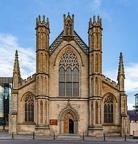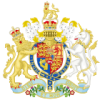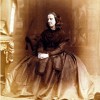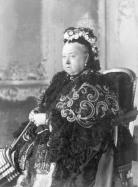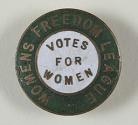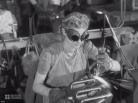Journey to Female Suffrage
Created by Natalie Mo on Mon, 06/19/2023 - 08:58
Part of Group:
We're tracking historical events that led to female suffrage
Timeline
Chronological table
| Date | Event | Created by | Associated Places | |
|---|---|---|---|---|
| 1753 |
Marriage Act 1753The Marriage Act of 1753 was also called "An Act for the Better Preventing of Clandestine Marriage" and Lord Hardwicke's Marriage Act. This required weddings to take place in an approved church or chapel. This act also set aside common law marriages. |
Katherine Muck | ||
| 1 Jan 1792 |
Vindication of the Rights of Woman
ArticlesAnne K. Mellor, "On the Publication of A Vindication of the Rights of Woman" Related Articles |
David Rettenmaier | ||
| Jan 1798 |
Memoirs of the Author of a VindicationOn January 1798, publication of William Godwin’s Memoirs of the Author of A Vindication of the Rights of Woman. The publication of this first biography of Wollstonecraft causes a scandal and Godwin publishes a second “corrected” edition of the Memoirs in the summer of the same year. ArticlesRelated ArticlesAnne K. Mellor, "On the Publication of A Vindication of the Rights of Woman" |
David Rettenmaier | ||
| 1823 |
Marriage Act of 1823The Marriage Act of 1823, added on to the original Marriage act of 1753. The first Act called for ceremonial marriage, no marriages in secret. The revised Act called for the consent of the women before marriage. Originally "unless young women were widowed, England did not allow independent marital consent"(Nelson, Heather). The Act changed this and opened the door for women to gain a little more authority when it came to their lives. It also relates to Charles Dickens' Bleak House, as we think of the different independent women throught the novel, Mrs. Jellyby, or Mrs Snagsby, who are more outspoken. They have a bit more edge in their marriages whereas other women may be in a more abusive marriage. It is interesting to look at the different women throughout the book and see how their social constructs vary. Nelson, Heather. “‘When a Daughter Elopes to Gretna, Generally It Is a Wicked Thing’: Female Consent, Clandestine Marriage, and Susannah Frances Reynolds's Gretna Green; Or, All for Love.” ANQ: A Quarterly Journal of Short Articles, Notes, and Reviews, volume 28, number 2, 2015, pages 79-86. Taylor & Francis, www.tandfonline.com/doi/abs/10.1080/0895769X.2015.1035367?journalCode=va.... |
Rachel Henriquez | ||
| 1836 |
Marriage Act 1836The Marriage Act 1836 legalized civil marriages in England and Wales. This meant that religious nonconformists and Catholics could marry in legally registered buildings or their place of worship. |
Katherine Muck | ||
| 28 Aug 1857 |
Matrimonial Causes Act of 1857
ArticlesKelly Hager, “Chipping Away at Coverture: The Matrimonial Causes Act of 1857″ Related ArticlesRachel Ablow, “‘One Flesh,’ One Person, and the 1870 Married Women’s Property Act” Jill Rappoport, “Wives and Sons: Coverture, Primogeniture, and Married Women’s Property” |
David Rettenmaier | ||
| 1858 |
English Woman’s Journal first published
Articles |
David Rettenmaier | ||
| 9 Aug 1870 |
1870 Married Women's Property Act
This Act established limited protections for some separate property for married women, including the right to retain up to £200 of any earning or inheritance. Before this all of a woman's property owned before her marriage, as well as all acquired after the marriage, automatically became her husband's alone. Only women whose families negotiated different terms in a marriage contract were able to retain control of some portion of their property. ArticlesRachel Ablow, "On the Married Woman's Property Act, 1870" Related ArticlesKelly Hager, “Chipping Away at Coverture: The Matrimonial Causes Act of 1857″ Jill Rappoport, “Wives and Sons: Coverture, Primogeniture, and Married Women’s Property” Anne Wallace, “On the Deceased Wife’s Sister Controversy, 1835-1907″ |
David Rettenmaier | ||
| 1894 |
New Woman Movement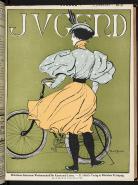 Image citation: Daughters of decadence: The New Woman in the Victorian fin de siècle. (2014, April 17). Retrieved October 02, 2020, from https://www.bl.uk/romantics-and-victorians/articles/daughters-of-decadence-the-new-woman-in-the-victorian-fin-de-siecle With the end of the 19th century came many new ideas of sexuality and empowerment. They set the stage for the New Women movement and the beginnings of feminist writings and publications. The New Woman movement was the beginning of the push for female autonomy that would continue into the twentieth century, and even the twenty-first. The New Woman movement placed a heavy emphasis on independence and autonomy of one’s self. (Bordin). The movement encouraged women to find economic and social stability without men, but also encouraged women to use their moral righteousness to persuade their husbands to virtue. This movement pushed for educated and independent women. However, the independence was not solely conceptual but pushed into changes in dress and actions which would expand the women’s domain into the broader world including the workforce. While many articles had been published throughout the 1880s and 1890s, the movement was fully realized with the publication of Sarah Grand’s essay, The New Aspect of the Woman Question. Grand condemned men who sexually strayed from their marriages causing the spread of sexually transmitted diseases. She also condemned wives, whom she referred to as ‘cow women’, who allowed their husbands to commit such acts. Grand claimed that this preserved gender inequality within marriages (Ledger). In Grand’s writing, she addresses the double standard of the expectation for women to remain sexually virtuous, while men were not. Grand claimed that women needed to hold their husbands to the higher moral standard and reform them from their infidelity. Additionally, Grand embraces female sexuality and talks about her heroine’s desires. Sexuality and identity were major parts of the New Woman movement. With new rights in terms of property and divorce, women could finally have intellectual and sexual autonomy (Ledger). The New Woman movement expanded on the ideas of women as the moral compass of society and called for their role to extend from the domestic sphere into the public sphere. Since women had the best interests of the country at heart, people claimed that a women’s role in the political sphere was not a contradiction to her domestic duties, but rather it was their extension and continuance (Tusan). Women’s great moral righteousness and selflessness would lead them to vote or speak on behalf of the better of the country. This idea of feminine selflessness resonated with the expected gender norms for the Victorian Era. While women did not receive the right to vote in England within the 19th century, these new ideas of women active outside of the home were the foundation for many arguments in favor of women’s suffrage. This movement generated many critiques. A major opponent to the New Woman movement, Eliza Lynn Linton, wrote about “Wild Women” an alternative version of the New Woman as a menace to society (Pykett). One of the major concerns with the New Woman was about the institution of marriage: “the New Woman herself, riding her bicycle in her bloomers and apparently in no need of assistance from anyone, led many people to believe, or fear, that a woman who could choose how she would live would no longer choose men” (MacPike). Previously, women had always existed in a subservient role to their husbands and any male relations in their life. This was partially due to their economic and legal reliance on these men; however, with laws changing and economic independence possible for women, men no longer held extreme power over women. In actuality, however, women were not free from the limitations and expectations of patriarchal society. Another concern was that the New Woman endangered not only social order but also natural order. Much of the medical community supported the idea that development of a woman’s brain caused infertility (Pykett). People concluded that the survival of humankind was endangered by women’s education. As pages spun off the printing press, the idea of the New Woman circulated across late-Victorian society. The New Woman movement was a reaction to the changes in women’s rights throughout that era. As a product of the Victorian Era, the movement refracted the contradictions and complexities about what it meant to be feminine. Writers of the New Woman movement explored and exposed these contradictions (Pykett). The New Woman articles and novels illustrate the complex views on women throughout the Victorian Era. Works Cited Bordin, Ruth Birgitta Anderson, excerpt from “Alice Freeman Palmer: the evolution of a new woman,” Digital Public Library of America, http://dp.la/item/61122e6aa1279a1b82af4add9cf9c814. Ledger, S. (2007). The new woman and feminist fictions. In G. Marshall (Ed.), The cambridge companion to the fin de siècle, cambridge (pp. 153-168). Cambridge: Cambridge University Press. doi:http://dx.doi.org.ezproxy.depaul.edu/10.1017/CCOL9780521850636.009 Retrieved from http://ezproxy.depaul.edu/login?url=https://www-proquest-com.ezproxy.dep... Pykett, Lyn. The 'Improper' Feminine : The Women's Sensation Novel and the New Woman Writing, Taylor & Francis Group, 1992. ProQuest Ebook Central, https://ebookcentral.proquest.com/lib/depaul/detail.action?docID=167885.
MacPike, Loralee. “The New Woman, Childbearing, and the Reconstruction of Gender, 1880-1900.” NWSA Journal, vol. 1, no. 3, 1989, pp. 368–397. JSTOR, www.jstor.org/stable/4315921. Accessed 1 Oct. 2020. Tusan, Michelle Elizabeth. “Inventing the New Woman: Print Culture and Identity Politics during the Fin-De-Siecle: 1997 VanArsdel Prize.” Victorian Periodicals Review, vol. 31, no. 2, 1998, pp. 169–182. JSTOR, www.jstor.org/stable/20083064. Accessed 20 Sept. 2020. |
Elena Sasso | ||
| 1894 |
"New Aspect of the Woman Question"In March 1894, Sarah Grand's “The New Aspect of the Woman Question” was published. The essay in North American Review, vol.158, no.448, March 1894, pp.270–6 has been credited with identifying the "New Woman." ArticlesMeaghan Clarke, “1894: The Year of the New Woman Art Critic” |
David Rettenmaier | ||
| May 1894 |
Story of a Modern WomanIn May 1894, Ella Hepworth Dixon's The Story of a Modern Woman was published. It is the best-known New Woman novel and draws on Dixon's own experiences supporting herself as a journalist. ArticlesMeaghan Clarke, “1894: The Year of the New Woman Art Critic” |
David Rettenmaier | ||
| 1897 |
The National Union of Women's Suffrage Societies was foundedThe foundation of the National Union of Women's Suffrage Societies was formed in 1897. Interestingly, the Queen herself denounced this association by stating her opinion that women have no place in voting. |
Cooper Gollier | ||
| 14 Oct 1897 |
Founding of the National Union of Women's Suffrage SocietiesOn October 16, 1896, approximately twenty leaders of women’s suffrage organizations in Britain gathered together at the Birmingham Conference to discuss the possibility of merging their individual societies into one joint organization. Because each society was fighting for the same overall goal-- women’s suffrage-- they decided that uniting their organizations would be a beneficial and powerful strategy (Hume 4, Vellacott 1). Thus, one year later, on October 14, 1897, the National Union of Women’s Suffrage Societies, commonly acronymized as NUWSS, was founded. At its founding, the NUWSS had seventeen member societies, including many of the largest and most influential women’s suffrage organizations in Britain at the time (Hume 4). The seventeen member societies branded themselves-- and the NUWSS as a whole-- as a non-militant, constitutional, and non-party-affiliated organization united to achieve women’s suffrage (Holton 1, Hume 5, Vellacott 1). In the early years, the role of the NUWSS was limited. Because each member society still functioned independently in its designated location and the NUWSS had no funds to support its members, the organization had little control over how the individual societies functioned. Instead of managing its members, the main duty of the NUWSS was to communicate with the Committee of Parliamentary Supporters of Women’s Suffrage (Hume 6, Vellacott 2). Direct communication with Members of Parliament was the first step in getting the government to hear and consider the idea of women’s suffrage (Hume 6). Spearheading the NUWSS after its founding was Millicent Garrett Fawcett who served as the president of the organization from 1898-1919 (Holton 1, Hume 7-8). Fawcett had experience with women’s rights, as she grew up with a father who was a strong believer in feminism and a sister who helped to pave the way for women in the medical field (Holton 1). Fawcett and many other members of NUWSS were described as women whose personalities closely resembled that of a typical Victorian woman. They were kind wives and mothers and gentle, loving figures all around (Hume 13). While this helped create a sense of camaraderie among the societies in the NUWSS, it was not helpful in their quest to have their issues heard or considered by the government. In general, 1897-1903 were building years for the NUWSS and were not as successful as perhaps the organization had hoped. The NUWSS tried to advocate for their cause, but they were often too gentle and did not fight to break the sex barriers to have their voices heard by Members of Parliament (Hume 9-11). After years of not having a single concern of theirs talked about in the House of Commons, the Committee of Parliamentary Supporters of Women’s Suffrage suggested that the individual member societies of the NUWSS directly approach Members of Parliament who lived in their area to communicate to them the importance of women’s suffrage (14). If Members of Parliament could be convinced women’s suffrage was an important cause, perhaps the entire Parliament would listen to the issue. In 1903, after the Boer War was over and a General Election was approaching, the NUWSS had a change in strategy. In late 1903, two-hundred women from the NUWSS and other women’s rights societies met for a convention in London (Holton 1, Hume 20-21). What is argued to be the most important aspect of the 1903 convention was the idea that going forward, the NUWSS would establish new committees in every county in Britain and Ireland (Hume 21). These new committees would commit themselves to consistently speaking with Members of Parliament and electoral candidates about the women’s suffrage issue as well as informing the general public about the importance of women’s suffrage and encouraging them to only support candidates who supported the cause (Hume 21, Vellacott 2). These actions helped to establish the NUWSS as a united, governing body rather than a collection of individual societies (Hume 21-22). After the 1906 election where the Liberal party secured its place in office, the NUWSS was hopeful that its campaigning efforts would lead the House of Commons to discuss women’s suffrage, but they were, once again, overly optimistic (Hume 23). After having no success in having their concerns heard, in July 1906, the NUWSS started a movement to speak to individuals in Parliament who were against women’s suffrage to try to convince them to rethink their position. Then, in October of the same year, the NUWSS announced it would sponsor a candidate who supported women’s suffrage (26). While all of these efforts were steps in the right direction in the overall goal of achieving women’s suffrage, the NUWSS was still a fairly new and growing society. In the following years, the organization had its share of ups and downs. It organized public events to further campaign for this cause, and it was eventually renamed the National Union of Societies for Equal Citizenship (Holton 4). The fight for equal voting rights for women continued into 1928 when it was finally achieved thanks, in part, to the work of the National Union of Women’s Suffrage Societies. Works Cited Holton, Sandra Stanley. “National Union of Women's Suffrage Societies (Act. 1896–1918).” Oxford Dictionary of National Biography, 24 May 2008, doi:10.1093/ref:odnb/96378. Hume, Leslie Parker. The National Union of Women's Suffrage Societies 1897-1914. Vol. 3, Routledge, 2016. Vellacott, Jo. Pacifists, Patriots and the Vote: The Erosion of Democratic Suffragism in Britain During the First World War. Palgrave Macmillan, 2014. |
Gracie Hart | ||
| 1899 to 1900 |
exampleexexex |
Natalie Mo | ||
| 28 Aug 1907 |
Deceased Wife's Sister's Marriage Act
ArticlesAnne Wallace, “On the Deceased Wife’s Sister Controversy, 1835-1907″ |
David Rettenmaier | ||
| Sep 1907 to 1961 |
Women's Freedom League and The VoteIn September of 1907, 77 members of the Women's Social and Political Union (WSPU), broke off and formed the Women's Freedom League (WFL). Two of the most prominent women who helped further popularize the WFL were Teresa Billington- Greig and Charlotte Despard. The Women's Freedom League was very different from its predecessor. For starters, they were suffragists. Unlike their predecessor (WSPU) which only allowed suffragettes. The WFL was a militant organization, much like the WSPU. They were willing to break the law but did so without vandalizing property or attacking politians. WFL used forms of non-violent protests, like demonstrations or tax resistance. The WFL was a completely non-violent, passive, organization and protested aganist WSPU's violent nature. It's popularity grew rapidly and had about 60 branches througout Britain. Clarie Eustance's thesis paper references all of the 60 branches, including their location and who was in charge of each WFL branch. The organization was twice the size of WSPU. They, eventually, had the abilty to fund their own newspaper The Vote in 1909. The Vote produced weekly report of WFL's activity. These reports enlightened the readers of the organization and activities in their local communities.
My article from Maria DiCenzo explains the importance of writing in the British Suffrage Movement. Within this article it mentions the Women's Freedom League grew in popularity by having its own newpaper The Vote. It also states that Teresa Billington- Greig and Charlotte Despard were the leading writing ladies for WFL. My source is by Claire Eustance. She right all of her information in her thesis paper. It is an extensive, well informing paper that guides the reader throughout all of the WFL movements. The paper starts with the reasons for the formation of WFL, getting funding for the succesful newpaper The Vote, oppsoing the Great war, and the conclusion of the movement in 1961. Charlotte Despard Simkin, John. Spartacus Educational. Spartacus Educational Publishers Ltd, https://spartacus-educational.com/Wdespard.htm Teresa Billington- Greig Simkin, John. Spartacus Education. Spartacus Educational Publishers Ltd, https://spartacus-educational.com/Wbillington.htm |
Tessa Albert | ||
| 17 Jun 1911 |
Women's Suffrage Procession at Coronation of George V The "From Prison to Citizenship" banner at the Women's Coronation Procession, London, 1911. Photo by the Museum of London/Heritage Images/Getty Images. In this famous suffrage procession marking the Coronation of George V, the banner designed by Laurence and created by Clemence in 1908 for the Kensington Women’s Social and Political Union made one of its numerous appearances in public parades. The striking banner, “From Prison to Citizenship,” features the suffragist colours, depicting a white figure on a purple background, decorated with green vines. The design was so popular it was also incorporated into a postcard for wider distribution. Clemence personally enacted this slogan later in 1911, when she spent a week in Holloway Prison for refusing to pay property taxes until she was granted full citizenship. Her act of civil disobedience did not grant her full citizenship, but it did add strength to the movement. Some women got the vote in 1918, but it took until 1928 for universal female suffrage to be achieved in the United Kingdom (Liddington, Vanishing). |
Lorraine Janzen Kooistra | ||
| 1918 |
Women's Suffrage in Britianhttp://ap.gilderlehrman.org/history-by-era/politics-reform/essays/sister... |
Elena Sasso | ||
| circa. 1928 |
Passing of Women's Legislation by ParliamentIn 1928, women in the United Kingdom were given universal suffrage. From that time up until World War II and beyond, more and more women began breaking the boundaries that were previously laid out for them and they began being a part of the work force and it was becoming more common for women to stray from the Cult of Domesticity. This was especially important during World War II when women had to step up and take the place of many of the jobs that men had previously held but now had to abandon to go to war. After the war, women were more respected but also more ridiculed because men were now intimidated by women because they saw how easily women could replace them in their jobs and how much women were truly capable of. This was an important period in time because although legally women were given equal rights in 1928 by Parliament, socially, there was still inequality between men and women. Women’s work towards the war effort showed men that they were capable and that they were deserving of their rights. Additionally, after World War II when many countries had to be rebuilt both physically and economically, the more help, the better. Therefore, I believe speaking about the newfound independence and freedom of women during this time is important to note when looking at this image. It is assumed that the woman in At Charley Brown's Pub, Limehouse is a sex worker, however, since she is dressed quite modestly, I believe an argument could be made that she was a woman coming off of a shift as well as the men who are assumed to be getting off of work. As you can see, the woman is in pants and a shirt with a long jacket over it. Although it was becoming more popuiar for women to wear pants rather than a skirt or dress, it could still be seen as a risque thing in the 1940s.
Evans, Sophie Jane. Those were the days: From England's pubs to Sheffield's steel industry and preparations for war - film archive reveals how life was in 1930s and 40s Britain. Daily Mail. 28 May. 2014. https://www.dailymail.co.uk/news/article-2641959/British-Council-film-ar... Accessed 29 Mar. 2022. Jones, Jasmine. 151 years of progress: A timeline of women's rights and gender equality in the UK. YahooLife. 8 Mar. 2017. https://www.yahoo.com/lifestyle/151-years-of-progress-a-timeline-of-wome... Accessed 29 Mar. 2022.
|
Marianna Balsamo |



